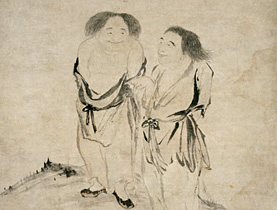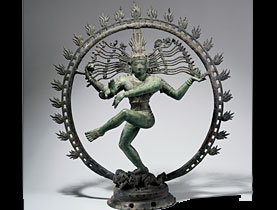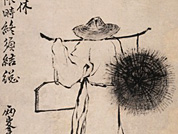Chinese artist emerges from the shadows

When Chinese artist Luo Ping unveiled his Ghost Scroll painting – of spectres he claimed to have seen with his own eyes – he caused both admiration and consternation.
The work forms the centre point of a Luo Ping exhibition at Zurich’s Rietberg Museum, the first of its kind devoted to the 18th century multi-talent and avowed eccentric.
The museum says that it wants to give the great master of Chinese art the international attention and acclaim that he has long deserved.
“Luo Ping is not well known so this exhibition is a kind of historical event,” chief curator Kim Karlsson told swissinfo.ch.
The show brings together 37 works by Luo Ping, members of his family, and his mentor Jin Nong. It includes masterpieces of national Chinese importance, some of which have never been seen before in the west.
Luo Ping – Eccentric Visions, which runs until July 12, will later move on to the Metropolitan Museum of Art in New York.
“I’m sure that the show will be a reason for scholars to come together and rethink this period of Chinese art, which is not very well researched,” added Karlsson.
Independent mind
Luo Ping (1733-1779) was a fiercely independent artist whose works influenced the course of later Chinese painting.
Born in Yangzhou in eastern China, the orphan’s artistic talents were recognised early. By the age of 23, he had been accepted as a student of the great Jin Nong, a towering and dominant figure in bohemian Yangzhou.
Both were among the “Eight Eccentrics of Yangzhou” a group of individualistic painters who challenged the traditional style of Chinese art.
“Luo Ping was very talented as a figure painter, he did landscape paintings and he was also known for his paintings of plum blossoms,” said Maxwell Hearn, Douglas Dillon curator for Chinese Painting and Calligraphy at the Metropolitan Museum, at the launch of the exhibition.
Luo Ping and Jin Nong worked together intensely for six years until Jin Nong’s death. Luo Ping may have even been a ghost painter for his mentor, Hearn said.
But it was with spectres of another kind that Luo Ping really made his mark. Having moved to the Chinese capital Beijing, and having made a name for himself – despite the city being far more culturally conservative than the swinging Yangzhou – Luo Ping presented the Ghost Amusement Scroll.
Ghost watcher
“He had green or blue eyes, which is very rare in China and he claimed that he was able to see ghosts. One of the most extraordinary paintings in the exhibition is a long handscroll with depictions of ghosts that Luo Ping apparently saw, ” Hearn told swissinfo.
Until the early 20th century, Luo Ping’s visions inspired people to add their own written comments and interpretations to the scroll. It now measures more than 25 metres long.
Karlsson said there was a lot more to the ghost scenes than first meets the eye.
“At that time there was a craze for ghostly lore, many well known scholars wrote ghost stories and everyone was very interested in the topic. It allowed them to deal with religious themes and social concerns,” the academic said.
The scroll shows a bald, fat ghost followed by a skinny “slave” ghost wearing an official’s hat, which is believed to point to corruption.
“But there were some critics of Luo Ping who said that he made the scroll as a well-timed curiosity, as a way of self staging,” added Karlsson.
Complicated man
Some of Luo Ping’s contemporaries saw the artist as a virtuous scholar, a pious Buddhist and a devoted family man. Others saw him as a wayward eccentric and a charming partygoer.
“Luo Ping was a very complicated man. He was an artist from a very early age, as was his wife, sons and daughter, so art was clearly a family business for them,” Hearn explained.
“He was also involved with the leading scholar officials of the day. He spent a great deal of his time in the capital where he did paintings for these men and he clearly participated in literary gatherings.”
In some ways, Luo Ping was ahead of his time. His marriage to fellow artist and great love Fang Wanyi at age 19 was, by 18th century Chinese standards, a very modern one, in which both partners were equal. The couple specialised in depictions of plum blossoms, some of which can be seen at the Rietberg exhibition.
Also showing a contemporary touch are Luo Ping’s unconventional pictures of leading Beijing figures, such as the Portrait of Mr Dongxin, where mentor Jin Nong is shown as a Buddhist monk or deity. Approaching his subjects with subtle irony, Luo Ping’s portraits go beyond the traditional Chinese style of the day.
Butterfly shoe
As he grew older and became destitute, Luo Ping retreated into the life of a Buddhist monk.
This took its toll, as seen in a gaunt anonymous portrait made of the artist shortly before his death. However, visitors will see a decadent “butterfly” shoe peeping out from underneath Luo Ping’s robes, showing that he had not forgotten his origins in Yangzhou.
Hearn, whose museum will show Luo Ping – Eccentric Visions in the autumn, said that the show was an extraordinary opportunity to get to know Chinese artists in all their complexity.
“Luo Ping was very much a man of his times,” he said. “And being called an eccentric also suggests that he had the kind of individuality that we associate with western artists.”
“So there is a lot here for westerners to discover about the common issues that artists face around the world.”
Isobel Leybold-Johnson in Zurich, swissinfo.ch
The exhbition runs from April 9 to July 12, 2009 at the Rietberg Museum in Zurich.
The two most important museums in China, the Palace Museum in Beijing and the Shanghai Museum, are involved as is The Metropolitan Museum of Art in New York.
It is the first ever comprehensive survey of Luo Ping’s work. The exhibition will also be shown at the MoMA from October 6, 2009 until January 10, 2010.

In compliance with the JTI standards
More: SWI swissinfo.ch certified by the Journalism Trust Initiative



You can find an overview of ongoing debates with our journalists here . Please join us!
If you want to start a conversation about a topic raised in this article or want to report factual errors, email us at english@swissinfo.ch.